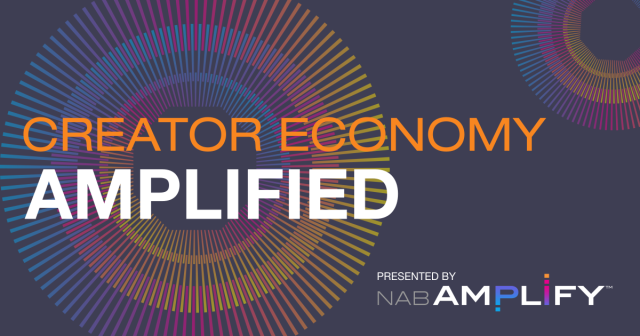
TL;DR
- Modern advertising strategies often require brands to dip their toes into the Creator Economy, however shallowly. But they must do so in a way that understands both how and why content is consumed and in which format.
- Also, as the lines blur between legacy media formats and user-generated content, brands cannot afford to ignore the significance of the Creator Economy.
- In an interview for NAB Amplify, Dennis Ortiz shares highlights from the consultancy’s recent study, The Creator Economy in 3D.
Do you know “what’s the right strategy to hit who you’re actually targeting?”
Deloitte Principal Dennis Ortiz says understanding consumer habits and the underpinnings of the Creator Economy are crucial to brand success.
“Different generations use different platforms, whether it’s legacy media or social media, for different reasons, and coming up with the right strategy to engage cross platform is likely going to hit optimal outcomes for advertisers,” Ortiz explains.
It’s important to understand the “why” behind certain types of media consumption.
Ortiz says, “Legacy media tends to be about immersion and experience.” For “Gen X and the older generations, they actually look at legacy media — TV shows, movies, etc. — as the most immersive form of entertainment.”
“Social media, on the other hand, is really more about connection and convenience,” he says. “Social media is driven by creators. And we actually have studies that suggest that, indeed, consumers are very attracted to creators that have similar interests, or shared ideas and values, and spend most of their time on social media following those types of creators that have those similar interests and values.”
One such study is Deloitte’s recently published The Creator Economy in 3D, which explores how social media, content creators and influencers are changing the way consumers interact with brands, media and advertising.
“A big part of this is not just the creators, but also the ability of the creators to create another forum for brands to connect with consumers,” Ortiz explains. “We actually have some research that would suggest that three out of five consumers are more likely to engage with a brand if one of their favorite creators actually recommend that brand.”
Deloitte’s study found the average consumer has five favored content creators, which they said “are the social media equivalent of a favorite TV show, perhaps with less regular schedules.” And for Gen Z, that number increases to 10.
This increase in social media time means the average person is engaging with many different voices in content from leading studios, micronetworks, and amateur user-generated content, to full-time content creators.
To be the most effective in driving followers’ purchasing decisions, the Deloitte study says “relatability” is key for content creators, meaning that they share a similar socioeconomic background and/or have hobbies/interests in common.
Also notable: “77% of consumer-creator relationships [Deloitte] surveyed could be traced to either a shared interest or desire to learn from that creator.” And for Gen Z specifically, aspiration is key; 45% indicated they follow “creators out of admiration for their lifestyle.”
“Online communities, Ortiz says, “are going to become increasingly important. That is why individuals are gravitating towards these platforms, because they’re able to find individuals or creators that are very similar to them or that they aspire to be.”
Understand Who Wants What
“Social media and user generated content will increasingly capture consumer attention,” Ortiz explains. In fact, “UGC is the primary form of entertainment for the younger generations.”
The study notes that “Gen Z and millennials spend 26% to 37% more time on social media than previous generations,” reinforcing those platforms as a good way to reach those target audiences.
And remember that the oldest members of the Millennial cohort are now 43 years old, and the youngest Gen Z are now 12 years old, according to Beresford Research, making both demos extremely desirable for many brands.
“I think that says a lot about where their consumption habits are, and where advertisers should be spending more of their dollars to capture that specific audience,” Ortiz says.
And why are Millennials and Gen Zers gravitating to social media? One explanation, per Ortiz, is that “social media platforms are now bringing a broader set of entertainment options to the table.”
Blurred Lines and New Opportunities
Take YouTube, for example. Ortiz says, “Now they have YouTube TV. They have the largest music library out there. They’re in podcasts, as well as gaming. YouTube now, as per a Nielsen report that came out in January, is the largest streaming service out there. And they’re … the fourth largest cable provider out there.”
With new generative AI tools entering the market all the time, UGC is also set to grow exponentially, and “that could continue to drive more eyeballs to the platform[s],” Ortiz predicts.
“The lines are blurring between legacy media, and what will be considered social media,” Ortiz emphasizes. “If you ask someone in the Gen Z age group… what movie they watch, they may be talking about a Mr. Beast movie that they saw on YouTube. Whereas if you ask some of the older generations, they might be talking about ‘Oppenheimer,’ which they saw in the theater or saw on streaming.”
Social media companies are no longer just competing with each other. He says, “What started as a creator-driven platform is now becoming an all encompassing entertainment platform. And so the legacy media companies should be thinking about ‘how do we play in that space, of being able to capture audience that might be diverting to other forms of media?’”
And companies should remember that “there is a symbiotic discovery relationship between social media and legacy media,” Ortiz says.
For example, “We have some research that suggests that consumers are driven towards specific television shows, as well as movies, based on what they’ve heard on social media.”


